
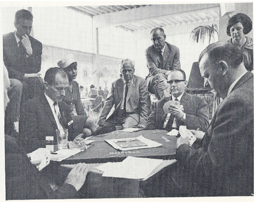 Just as I finished last week’s article on Easter Eggs, I received a mail announcing that Hans Kreijns had passed away at the age of 83. Hans Kreijns was by far the best known player in The Netherlands and probably the most successful one as well. His bridge playing career started around 1950 and lasted for almost 6 decades, until health problems forced him to stop playing soon after his 80th birthday in 2008. In those 6 decades, he set the unique record of winning every major event in the country at least once, and lots of them multiple times. He also won a world championship, the 1966 open pairs together with Bob Slavenburg. Picture on the left with Hans Kreijns sitting west and Slavenburg east against an unknown opponent. Note the absence of screens and bidding boxes, but the presence of cigarettes.
Just as I finished last week’s article on Easter Eggs, I received a mail announcing that Hans Kreijns had passed away at the age of 83. Hans Kreijns was by far the best known player in The Netherlands and probably the most successful one as well. His bridge playing career started around 1950 and lasted for almost 6 decades, until health problems forced him to stop playing soon after his 80th birthday in 2008. In those 6 decades, he set the unique record of winning every major event in the country at least once, and lots of them multiple times. He also won a world championship, the 1966 open pairs together with Bob Slavenburg. Picture on the left with Hans Kreijns sitting west and Slavenburg east against an unknown opponent. Note the absence of screens and bidding boxes, but the presence of cigarettes.
Now, I’m not going to write another obituary, people have done that before me and I’d just be repeating what they said. Here are some links if you want to read one:
- Dutch Bridge Federation.
- Bridge Topics and
- Erwin Witteveen. (My favorite one).
- ... and that is probably not all ...
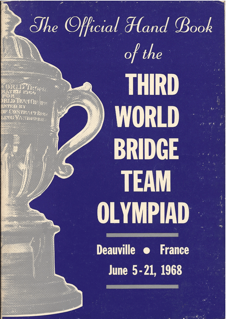 Instead, I’m going to show some vintage material showing Kreijns at the top of his game in the mid 1960’s. Of course, there was the world pairs championship in 1966 but Kreijns-Slavenburg also qualified for the 1966 Bermuda Bowl (after finishing 2nd in the Europeans, behind Italy) and did well in the 1968 Olympiad. Most hands of those events are recorded in the championship books that the ACBL has been publishing since 1953.
Instead, I’m going to show some vintage material showing Kreijns at the top of his game in the mid 1960’s. Of course, there was the world pairs championship in 1966 but Kreijns-Slavenburg also qualified for the 1966 Bermuda Bowl (after finishing 2nd in the Europeans, behind Italy) and did well in the 1968 Olympiad. Most hands of those events are recorded in the championship books that the ACBL has been publishing since 1953.
By the way, did I ever write that I collect these books? The books of the 1966 pairs event and 1968 Olympiad are in my collection, but the 1966 Bermuda Bowl book is missing. If you have this and want to get rid of it, then you know where to find me. The same is true for a few other ones before 1975.
Anyway, back to the 1968 Olympiad. It was played as a round robin amongst the 33 teams that participated, followed by play-offs amongst the top 4. The Dutch finished 3rd in the round robin, which meant that they’d play the US in the semi-finals. The other final was Italy against Canada.
The Dutch team consisted of Kreijns-Slavenburg, Kokkes-van Heusden and Rebattu-Rebattu. Kreijns and Slavenburg were the anchor pair of the team, remarkably, they played every board of the round robin (3 20-board matches a day, for 11 days) and semi-finals (80 boards). That alone was sufficient to give them the nickname “Iron Men”. Incidentally, they weren’t the only pair of Iron Men, Canadians Murray and Kehela did the same thing and got the same nickname.
Kreijns-Slavenburg were known for their natural style. Their convention card was about 10 lines long and didn’t list much more than Stayman and Blackwood. Note that a lack of conventions did not imply that they didn’t know what they were doing. They actually knew quite well what their partner’s bids meant, it was just that those understandings were completely natural. Declarer play was great. An example of both:
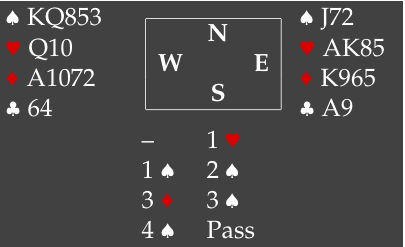
1♥ was the standard opening bid in those days. Negative doubles were not in use and the heart suit could get lost easily after 1♦-(1♠), opening 1♥ avoided that and the diamonds would come later. Note the modern, by today’s standards, raise to 2♠ on a 3 card suit. Also note the 3♠ bid and raise to 4, where most modern players would bid 4♠ by east themselves as well as pass 3♠ as west. A few boards later, Kreijns-Slavenburg NS:
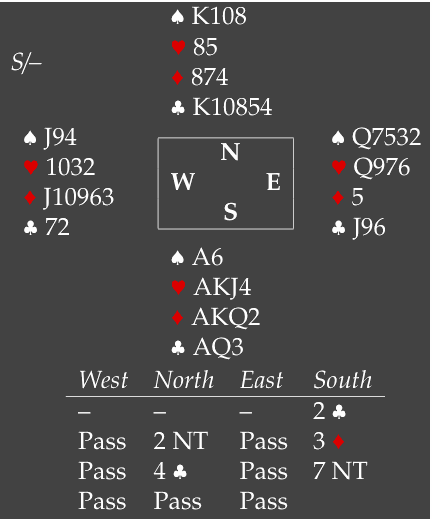
2♣ was strong, 2NT showed a few points but denied any aces, the next bids were natural, 4♣ showing 5 as suits were bid up the line over 2NT.
East lead the ♠3 to the 6, J and K. At first sight, it looks as if the contract depends only on the ♥Q finesse, but it is actually a bit better than that. Declarer cashed 3 rounds of diamonds, the ♠A and then played 5 rounds of clubs. On the last club, east is squeezed in the majors. At the other table, the US pair showed a balanced 27 count, raised to 6NT by partner, making 13 tricks too, but losing 11 imps.
The Dutch have always said that they are unlucky in the slam department. I don’t know when that started, but it was true in this match as well. The final margin was mainly due to a misunderstanding in the slam zone by van Heusden-Kokkes and this hand:
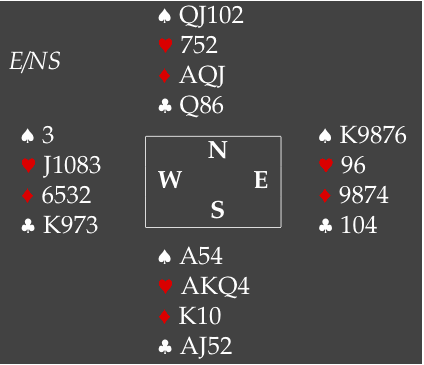
You are in 6NT on a ♦6 lead that you win in dummy. Even double dummy, it is a nice puzzle.
The logical first step is to finesse twice in spades. On the second spade, west discards the ♦3. Now what?
The next logical play seems to take a club finesse but that is wrong. Even if it wins, you still don’t have 12 tricks.
Instead, go for split kings and make the somewhat counter intuitive play of cashing ♥AK and ♠A, then play a small club to the ♣Q. West cannot win (that would set up the 12th trick for declarer). Now cash the ♦A. West will be down to ♥JT and ♣K9. ♥7 to the ♥Q and a heart end-plays him. The contract makes whenever the ♠K and ♣K are in different hands.
This was missed, at the table, by both Hans and another hero of mine, Edgar Kaplan. I’m not going to blame either of them for this, it did take me longer than the time they get to play a hand, to figure this out myself too.
As I said, the Dutch lost their semi-final by about 30 imp’s. Duplicated boards had not been introduced back then so it is hard to objectively show which pairs did best. But looking at the hands, it does look as if most points were lost at the other table. Kreijns and Slavenburg put up a solid performance throughout the 80 boards, with no signs of fatigue, even after playing 60 boards a day for 12 days in a row.
The rest of the tournament was predictable: Italy (with a team that included Belladonna, Garozzo and Forquet) won easily against Canada, then beat the US in the finals for their 10th world championship in 11 years. The Netherlands lost the play-off for 3rd and 4th place. Hans did get his revenge 12 years later though, when he won bronze at the 1980 Olympics.
Bottom line for today, the game has lost a great champion who was also always a gentleman at the table. He’ll be missed.
